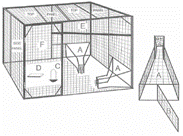Eastern Wildlife Damage Control Conferences
Date of this Version
October 1997
Document Type
Article
Abstract
Birds, especially gulls (Larus spp.), are attracted to landfills, and when landfills are close to airports, birds can pose a threat to aircraft safety. We conducted a 1-year ecological study to address concerns of the Federal Aviation Administration (FAA) and Accomack County, Virginia, officials over potential wildlife hazards caused by the Accomack County Southern Landfill. During 48 surveys conducted from December 1995 to December 1996, we observed 112,693 birds at the landfill ( x =503). Nine species represented 97% of all observations. Bird numbers varied during the year, increasing during winter and declining during summer. Bird abundance appeared unaffected by trash baling, with 629 and 612 birds per observation before and after implementation of a trash baling program on 24 January 1996, respectively. Bird management methods instituted by the landfill included harassment, exclusion, repellents, shooting, and habitat alteration. Pyrotechnics and pyrotechnics supplemented with shooting were used inconsistently and had only limited and temporary effects. Bird abundance actually increased 43% and 172% for gulls and crows (Corvus brachyrhynchos), respectively, while harassment supplemented by shooting was being conducted. Birds appeared to prefer bare (unvegetated) ground or trash habitats. We recommend continuing harassment of birds with pyrotechnics supplemented with shooting and limiting the amount of bare ground. Wildlife damage management should be conducted by professional biologists because when methods are applied inappropriately or inconsistently, desired results are difficult to achieve.



Comments
Published in Proceedings of the Eighth Eastern Wildlife Damage Management Conference, Roanoke, Virginia, October 16–19, 1997, edited by James A. Parkhurst. Copyright © 1997 by the authors.